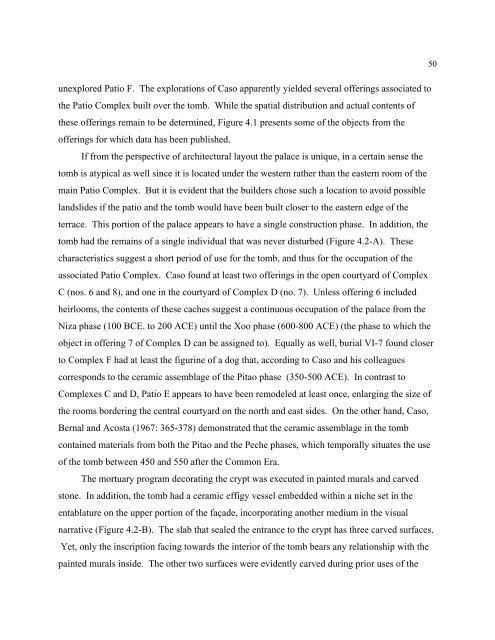You also want an ePaper? Increase the reach of your titles
YUMPU automatically turns print PDFs into web optimized ePapers that Google loves.
unexplored Patio F. The explorations of Caso apparently yielded several offerings associated to<br />
the Patio Complex built over the tomb. While the spatial distribution and actual contents of<br />
these offerings remain to be determined, Figure 4.1 presents some of the objects from the<br />
offerings for which data has been published.<br />
If from the perspective of architectural layout the palace is unique, in a certain sense the<br />
tomb is atypical as well since it is located under the western rather than the eastern room of the<br />
main Patio Complex. But it is evident that the builders chose such a location to avoid possible<br />
landslides if the patio and the tomb would have been built closer to the eastern edge of the<br />
terrace. This portion of the palace appears to have a single construction phase. In addition, the<br />
tomb had the remains of a single individual that was never disturbed (Figure 4.2-A). These<br />
characteristics suggest a short period of use for the tomb, and thus for the occupation of the<br />
associated Patio Complex. Caso found at least two offerings in the open courtyard of Complex<br />
C (nos. 6 and 8), and one in the courtyard of Complex D (no. 7). Unless offering 6 included<br />
heirlooms, the contents of these caches suggest a continuous occupation of the palace from the<br />
Niza phase (100 BCE. to 200 ACE) until the Xoo phase (600-800 ACE) (the phase to which the<br />
object in offering 7 of Complex D can be assigned to). Equally as well, burial VI-7 found closer<br />
to Complex F had at least the figurine of a dog that, according to Caso and his colleagues<br />
corresponds to the ceramic assemblage of the Pitao phase (350-500 ACE). In contrast to<br />
Complexes C and D, Patio E appears to have been remodeled at least once, enlarging the size of<br />
the rooms bordering the central courtyard on the north and east sides. On the other hand, Caso,<br />
Bernal and Acosta (1967: 365-378) demonstrated that the ceramic assemblage in the tomb<br />
contained materials from both the Pitao and the Peche phases, which temporally situates the use<br />
of the tomb between 450 and 550 after the Common Era.<br />
The mortuary program decorating the crypt was executed in painted murals and carved<br />
stone. In addition, the tomb had a ceramic effigy vessel embedded within a niche set in the<br />
entablature on the upper portion of the façade, incorporating another medium in the visual<br />
narrative (Figure 4.2-B). The slab that sealed the entrance to the crypt has three carved surfaces.<br />
Yet, only the inscription facing towards the interior of the tomb bears any relationship with the<br />
painted murals inside. The other two surfaces were evidently carved during prior uses of the<br />
50

















